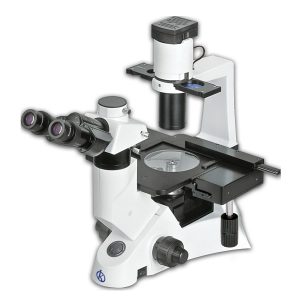Influenzavirus A is a genus of virus belonging to the family Orthomyxoviridae. It is the virus that causes influenza A disease; influenza A is generally stronger and more virulent than the other minor antigenic variants. Influenza A virus usually causes disease only in birds, but it can infect several mammalian species, including humans. The known subtypes of this virus are endemic to birds, so it is considered a bird disease, yet due to the contagion that has occurred in humans in recent years, especially in countries in Asia, it is a virus that is closely monitored.
Several tests are available to detect influenza A virus in respiratory samples, commonly used are rapid diagnostic tests that detect antigens, which stimulate the immune response. Of course, some of these assays require the use of electron microscopy or immunofluorescence microscopy for virus visualization.
Immunofluorescence microscope in detection of influenza A virus
Immunofluorescence tests are a type of test in which antigen detection is sought using fluorescence microscopes to obtain results, these tests usually yield results within 2 to 4 hours and have good sensitivity and specificity. The assays used with the fluorescence microscope are direct antibody fluorescent staining (DFA) and indirect antibody fluorescent staining (IFA), both of which are used in the detection of influenza A antigens. Both techniques are explained below:
- DFA: based on the treatment of respiratory epithelial cells with specific antibodies conjugated with fluorescent dyes, then a monoclonal antibody is applied. The sample should then be viewed under the fluorescence microscope. It is a very useful diagnostic test because it produces fast and accurate results.
- IFA technique: through this technique, antigens of microorganisms or viruses to which fluorescein-stained antibodies have been fixed can be detected. The sample is examined under a fluorescence microscope.
Fluorescence microscopes are a type of conventional microscope that is characterized by the addition of a fluorescence adaptor to be able to visualize samples with fluorescence contrast. The fluorescence microscope uses a light intensity greater than the visible light used by conventional microscopes, so the light excites the fluorescence-labeled samples.
Electron microscopy in influenza A virus detection
On the other hand, electron microscopy is used with the viral isolation technique. This technique is widely used in the detection of viral infections, because it is highly sensitive. For influenza virus detection, this is one of the best options. Viral culture is based on culture of the virus in cells or embryonic eggs. Later the sample is observed under the electron microscope, since this has greater increase.
The electron microscope is a large laboratory equipment which uses an electron beam to visualize the images, instead of visible light, since with the latter you can not observe agents as small as viruses. It is basically composed of a 1.5 meter column, a high vacuum system and a high voltage generator, to produce the electron beam that will impact the sample. With electron microscopes it is possible to have an increase of about 1,000,000x, making it easier to see viruses, chromosomes, DNA molecules or atoms.
Kalstein-branded microscopes
Kalstein is a company dedicated to the sale of medical and laboratory equipment, but also with the advantage of being the MANUFACTURERS of each of these equipment, which is why, they are characterized by being of high quality and technology. We have microscopes at the best PRICES on the market, within our models you can find the YR series biological microscope whose specifications are: HERE
- Clear picture display with excellent optical function Small space occupancy with integral stand design, low environmental requirements with anti-mold technology.
- Convenient operation with ergonomic design principle.
When you make the PURCHASE with us, we assure you that you will be advised at all times, in order to clarify your doubts. To see our microscope catalog go to HERE

